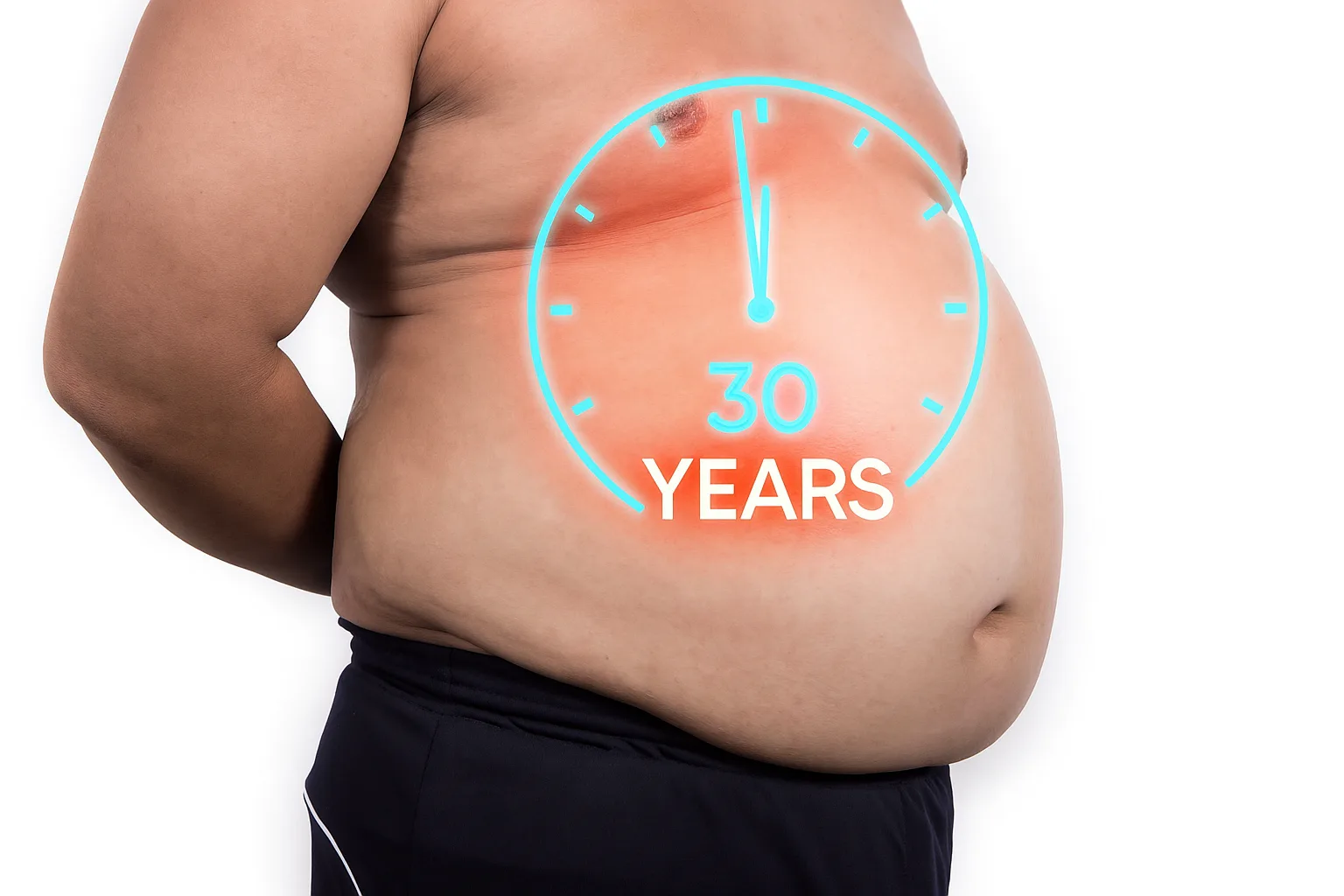7 Key Takeaways
- Hormones shift after 30 causing fat storage around the belly.
- Slower metabolism & muscle loss make fat loss harder.
- Stress & poor sleep increase cortisol and hunger hormones.
- Sedentary lifestyle and less movement accelerate belly fat.
- Unhealthy eating & alcohol contribute to visceral fat buildup.
- Genetics play a role, but lifestyle changes still matter.
- The best defense: strength training, balanced diet, stress management, and quality sleep.
Introduction: Why Does Belly Fat Sneak Up After 30?
You wake up one morning, glance in the mirror, and notice it—your waistline isn’t as flat as it used to be. Clothes fit differently, and that stubborn pouch around your midsection seems harder to get rid of than ever before. If this sounds familiar, you’re not alone. Belly fat after 30 is one of the most common health struggles people face, even if they were slim in their 20s.

The truth is, your body changes with age. Hormones shift, metabolism slows, stress piles up, and life responsibilities often leave less time for exercise and healthy eating. This creates the perfect storm for extra fat to settle around the abdomen. But here’s the good news: while it may be more challenging, it’s absolutely possible to reverse the trend with the right strategies.
In this article, we’ll break down the top causes of belly fat after 30—from hormonal changes and stress to sleep and lifestyle habits. More importantly, we’ll explore practical, science-backed solutions you can start applying today to take control of your health and reclaim your waistline.
Read Also: The Role of Water in Weight Loss: What You Need to Know
Why Belly Fat After 30 Is Different
Before diving into the causes, let’s clarify why belly fat after 30 feels so different. Belly fat isn’t just a cosmetic concern—it’s linked to visceral fat, the type of fat that surrounds your internal organs. Unlike subcutaneous fat (just under the skin), visceral fat is metabolically active and can increase your risk of type 2 diabetes, heart disease, and inflammation.
That’s why addressing belly fat isn’t just about looking good—it’s about protecting your long-term health.
Top Causes of Belly Fat After 30
1. Hormonal Shifts and Imbalances

One of the biggest culprits is hormonal change. After 30, both men and women experience shifts in hormones that affect fat storage.
- In women: Declining estrogen levels in the years leading to menopause cause fat to redistribute from hips and thighs to the abdomen.
- In men: Testosterone levels naturally drop, reducing muscle mass and slowing metabolism, which makes it easier to gain fat in the belly.
FIX:
Include foods that support estrogen balance, such as flaxseeds and leafy greens. For men focus on Strength training as this can help preserve testosterone levels and muscle mass. Also, avoid processed foods and added sugars that disrupt hormonal balance.
2. Slower Metabolism
After age 30, metabolism slows by about 1–2% per decade due to loss of muscle mass and changes in energy needs. This means you burn fewer calories at rest than you used to.
How to Fight Back:
Prioritize strength training to preserve and build lean muscle. Additionally, add small amounts of high-intensity interval training (HIIT) for calorie burn. Focus on protein-rich foods to maintain satiety and muscle repair.
3. Stress and Cortisol Overload
Life after 30 often comes with more responsibilities—career pressures, financial stress, family obligations. Chronic stress raises cortisol levels, a hormone strongly linked to fat accumulation in the abdominal area.
How to Fight Back:
- Practice stress-reducing activities like meditation, deep breathing, or walking in nature.
- Limit caffeine and alcohol, which elevate cortisol.
- Ensure downtime and sleep to regulate stress hormones.
4. Poor Sleep Habits

Lack of quality sleep is a hidden cause of belly fat. Studies show that adults who get fewer than 7 hours of sleep per night are more likely to accumulate visceral fat. Sleep deprivation also disrupts hunger hormones (ghrelin and leptin), making you crave unhealthy foods.
How to Fight Back:
- Aim for 7–9 hours of quality sleep.
- Establish a consistent bedtime routine (dim lights, no screens 1 hour before bed).
- Avoid heavy meals and caffeine close to bedtime.
5. Sedentary Lifestyle
Sitting for long hours—whether at a desk job or watching TV—slows calorie burn and reduces fat metabolism. Without consistent movement, belly fat builds up quickly.
How to Fight Back:
- Take a 5-minute walk every hour if you sit at work.
- Use standing desks or walk during phone calls.
- Add daily movement beyond the gym (house chores, cycling, stairs).
6. Unhealthy Eating Patterns

Processed foods, sugary snacks, late-night meals, and oversized portions—all contribute to belly fat. After 30, your body doesn’t tolerate junk food as well as it once did, and insulin resistance becomes more likely.
How to Fight Back:
- Focus on whole foods: lean proteins, vegetables, whole grains, and healthy fats.
- Cut back on refined carbs and added sugars.
- Try intermittent fasting (16:8) if it fits your lifestyle—it can help reduce visceral fat.
Read Also: 5 Working Hacks to Shed Fat Fast: Skip if you can’t be disciplined and consistent.
7. Alcohol Consumption
Alcohol, especially beer and cocktails, adds empty calories and promotes fat storage in the abdominal area. The term “beer belly” isn’t just a myth—it’s physiology.
How to Fight Back:
- Limit alcohol to moderate levels (1 drink/day for women, 2 for men).
- Choose lower-calorie options like wine or spirits mixed with soda water.
- Have alcohol-free days each week.
8. Age-Related Muscle Loss
Muscle naturally declines after 30, which reduces calorie-burning capacity. Less muscle = slower metabolism = more belly fat.
How to Fight Back:
- Lift weights at least 2–3 times per week.
- Include bodyweight exercises (push-ups, squats, planks).
- Don’t neglect protein intake—muscles need fuel to grow.
9. Genetics and Family History
If belly fat runs in your family, you may be genetically predisposed to carry fat in your midsection. While you can’t change genetics, you can change how you manage lifestyle risk factors.
How to Fight Back:
- Be proactive about lifestyle habits early.
- Monitor waist circumference as a health marker.
- Focus on habits you can control—exercise, diet, sleep, and stress.
10. Decline in Physical Activity with Age
After 30, many people become busier with work and family, leaving less time for physical activity. The gradual decline in energy expenditure plays a huge role in belly fat.
How to Fight Back:
- Schedule workouts as appointments.
- Incorporate movement into daily life.
- Start with small, consistent habits instead of extreme changes.
Foods That Help Fight Belly Fat After 30

- Lean protein: chicken, fish, legumes
- Fiber-rich foods: oats, beans, vegetables
- Healthy fats: avocados, nuts, olive oil
- Anti-inflammatory foods: turmeric, green tea, berries
- Hydrating foods: cucumbers, watermelon
Lifestyle Strategies That Work
- Combine cardio + strength training
- Manage stress & sleep consistently
- Eat balanced meals and practice mindful eating
- Stay hydrated (water helps reduce bloating and appetite)
- Track progress using waist circumference, not just the scale
Conclusion
Belly fat after 30 may feel like an unavoidable reality, but science shows it’s not inevitable. By addressing hormonal changes, lifestyle habits, stress, and nutrition, you can prevent and reduce abdominal fat. Remember, small daily choices add up—choose movement, eat whole foods, prioritize rest, and manage stress.
With consistency, not only can you reclaim your waistline, but you’ll also reduce your risk of chronic diseases and feel more energetic in your 30s, 40s, and beyond.



